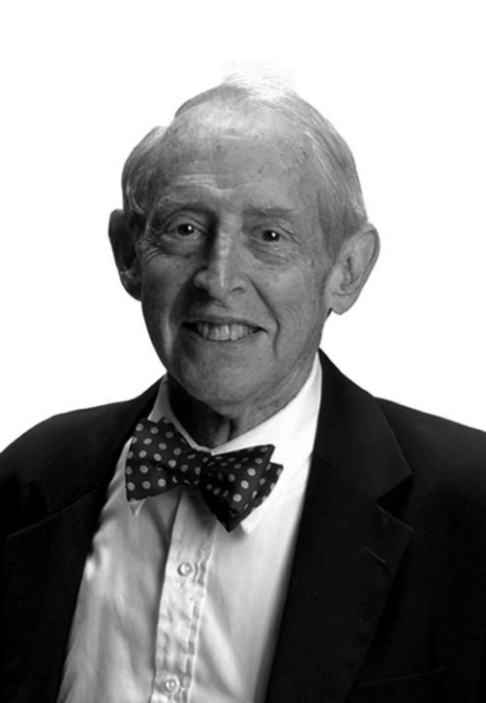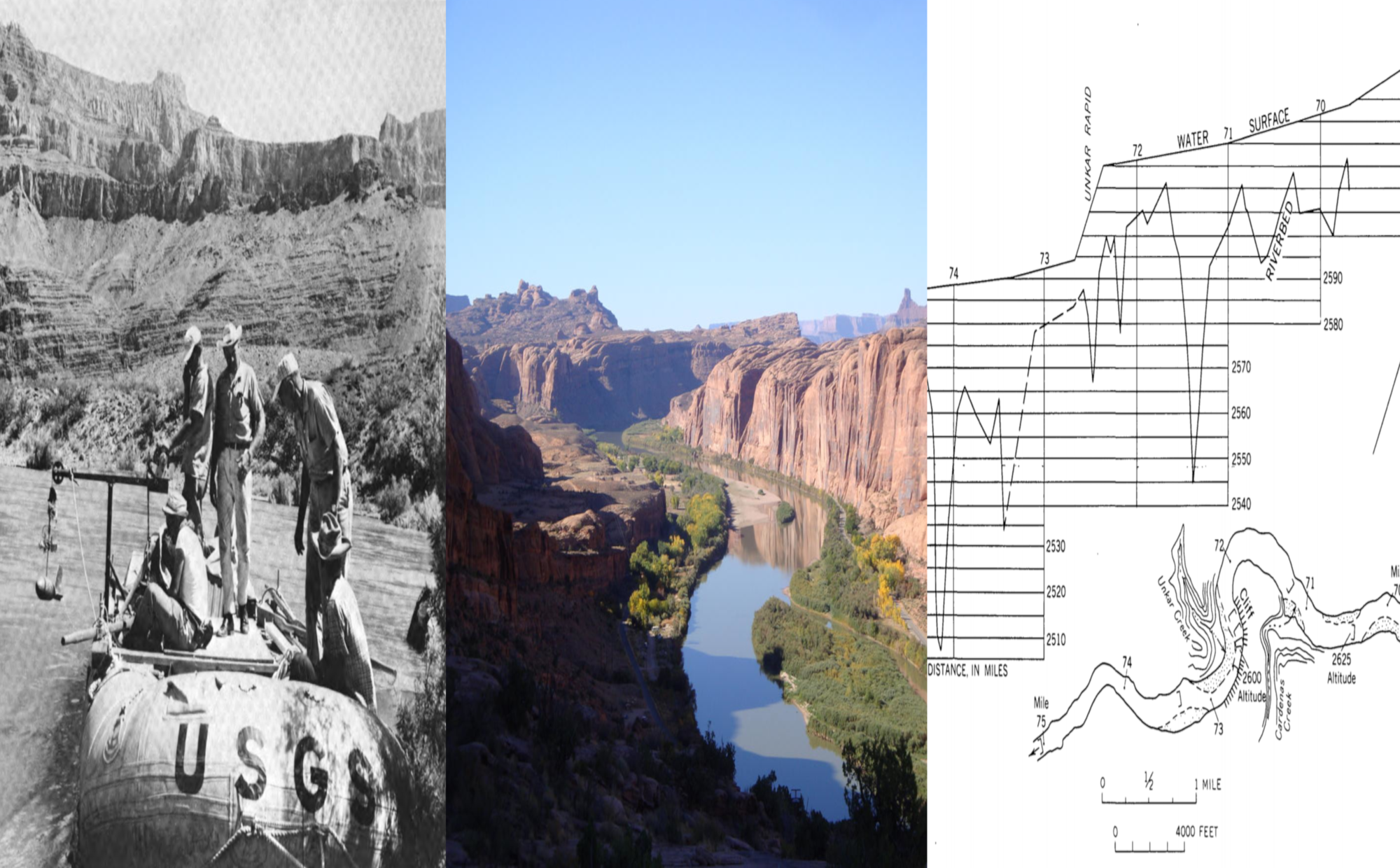M. Gordon “Reds” Wolman—nicknamed for the vibrant color of his hair—was born in Baltimore, Maryland in 1924. After attending Haverford College for one semester in 1942 Wolman was drafted to serve in the Navy, but returned to school to complete his BA in geology at Johns Hopkins when WWII ended. After receiving his PhD in geology from Harvard, Wolman worked for the USGS from 1951-58, where his work focused on the quantitative analysis of river channels and floodplains. He returned to academia from 1958, chairing first the Geography department and later the Department of Geography and Environmental Engineering (DOGEE) at his alma mater. He died in 2010.
Wolman is considered a founder of the modern quantitative approach to fluvial geomorphology. While at USGS, his research—which brought together hydraulic theory, laboratory experimentation, and field measurements—generated new and more flexible methods for understanding and modeling the wide variation in river and channel behavior. He worked closely with Luna Leopold: together with John Miller, the trio authored Fluvial Processes in Geomorphology (1964), a textbook that became, and remains, a foundational work in the discipline.
From the 1960s, Wolman’s attention turned to urban water infrastructure, a decision influenced by his father, Abel, who advised cities around the world on water management and, like his son, taught at Johns Hopkins. Focusing on the impact of urbanization on sedimentation in stream channels as well as temporal trends in water quality, Wolman’s later work was particularly relevant to policy discussions around how to manage and manipulate water supplies. While advising on water-related governance both at the local and global level, Wolman was also a dedicated teacher who shaped DOGEE around interdisciplinary work, explaining that “the rationality for interdisciplinary studies is based on the common observation that problems in the real world are not separable into disciplines” (Wolman, 1977). His students spent time in labs and lectures, as well as in the field around Baltimore, learning through water that natural and social processes are inextricably linked.
Publications
2248324
Wolman
chicago-fullnote-bibliography
50
530
https://www.riversofdata.org/wp-content/plugins/zotpress/
%7B%22status%22%3A%22success%22%2C%22updateneeded%22%3Afalse%2C%22instance%22%3A%22zotpress-12e49ac6809ae54ab58cf436643e8bb1%22%2C%22meta%22%3A%7B%22request_last%22%3A0%2C%22request_next%22%3A0%2C%22used_cache%22%3Atrue%7D%2C%22data%22%3A%5B%7B%22key%22%3A%2264PREH4A%22%2C%22library%22%3A%7B%22id%22%3A2248324%7D%2C%22meta%22%3A%7B%22creatorSummary%22%3A%22Leopold%20and%20Wolman%22%2C%22parsedDate%22%3A%221960-06-01%22%2C%22numChildren%22%3A0%7D%2C%22bib%22%3A%22%3Cdiv%20class%3D%5C%22csl-bib-body%5C%22%20style%3D%5C%22line-height%3A%201.35%3B%20padding-left%3A%201em%3B%20text-indent%3A-1em%3B%5C%22%3E%5Cn%20%20%3Cdiv%20class%3D%5C%22csl-entry%5C%22%3ELeopold%2C%20Luna%20B.%2C%20and%20M.%20Gordon%20Wolman.%20%26%23x201C%3BRiver%20Meanders.%26%23x201D%3B%20%3Ci%3EGSA%20Bulletin%3C%5C%2Fi%3E%2071%2C%20no.%206%20%28June%201%2C%201960%29%3A%20769%26%23x2013%3B93.%20%3Ca%20href%3D%27https%3A%5C%2F%5C%2Fdoi.org%5C%2F10.1130%5C%2F0016-7606%281960%2971%5B769%3ARM%5D2.0.CO%3B2%27%3Ehttps%3A%5C%2F%5C%2Fdoi.org%5C%2F10.1130%5C%2F0016-7606%281960%2971%5B769%3ARM%5D2.0.CO%3B2%3C%5C%2Fa%3E.%3C%5C%2Fdiv%3E%5Cn%3C%5C%2Fdiv%3E%22%2C%22data%22%3A%7B%22itemType%22%3A%22journalArticle%22%2C%22title%22%3A%22River%20Meanders%22%2C%22creators%22%3A%5B%7B%22creatorType%22%3A%22author%22%2C%22firstName%22%3A%22Luna%20B.%22%2C%22lastName%22%3A%22Leopold%22%7D%2C%7B%22creatorType%22%3A%22author%22%2C%22firstName%22%3A%22M.%20Gordon%22%2C%22lastName%22%3A%22Wolman%22%7D%5D%2C%22abstractNote%22%3A%22%22%2C%22date%22%3A%221960%5C%2F06%5C%2F01%22%2C%22language%22%3A%22en%22%2C%22DOI%22%3A%2210.1130%5C%2F0016-7606%281960%2971%5B769%3ARM%5D2.0.CO%3B2%22%2C%22ISSN%22%3A%220016-7606%22%2C%22url%22%3A%22https%3A%5C%2F%5C%2Fpubs.geoscienceworld.org%5C%2Fgsa%5C%2Fgsabulletin%5C%2Farticle%5C%2F71%5C%2F6%5C%2F769%5C%2F5195%5C%2Friver-meanders%22%2C%22collections%22%3A%5B%5D%2C%22dateModified%22%3A%222020-06-25T16%3A04%3A38Z%22%7D%7D%2C%7B%22key%22%3A%22DWVB95MN%22%2C%22library%22%3A%7B%22id%22%3A2248324%7D%2C%22meta%22%3A%7B%22creatorSummary%22%3A%22Leopold%20and%20Wolman%22%2C%22parsedDate%22%3A%221957%22%2C%22numChildren%22%3A0%7D%2C%22bib%22%3A%22%3Cdiv%20class%3D%5C%22csl-bib-body%5C%22%20style%3D%5C%22line-height%3A%201.35%3B%20padding-left%3A%201em%3B%20text-indent%3A-1em%3B%5C%22%3E%5Cn%20%20%3Cdiv%20class%3D%5C%22csl-entry%5C%22%3ELeopold%2C%20Luna%20B.%2C%20and%20M.%20Gordon%20Wolman.%20%3Ci%3ERiver%20Channel%20Patterns%3A%20Braided%2C%20Meandering%2C%20and%20Straight%3C%5C%2Fi%3E.%20US%20Government%20Printing%20Office%2C%201957.%3C%5C%2Fdiv%3E%5Cn%3C%5C%2Fdiv%3E%22%2C%22data%22%3A%7B%22itemType%22%3A%22book%22%2C%22title%22%3A%22River%20channel%20patterns%3A%20braided%2C%20meandering%2C%20and%20straight%22%2C%22creators%22%3A%5B%7B%22creatorType%22%3A%22author%22%2C%22firstName%22%3A%22Luna%20B.%22%2C%22lastName%22%3A%22Leopold%22%7D%2C%7B%22creatorType%22%3A%22author%22%2C%22firstName%22%3A%22M.%20Gordon%22%2C%22lastName%22%3A%22Wolman%22%7D%5D%2C%22abstractNote%22%3A%22%22%2C%22date%22%3A%221957%22%2C%22language%22%3A%22%22%2C%22ISBN%22%3A%22%22%2C%22url%22%3A%22%22%2C%22collections%22%3A%5B%5D%2C%22dateModified%22%3A%222020-06-25T16%3A04%3A34Z%22%7D%7D%2C%7B%22key%22%3A%22SMHCNL9I%22%2C%22library%22%3A%7B%22id%22%3A2248324%7D%2C%22meta%22%3A%7B%22creatorSummary%22%3A%22Leopold%20et%20al.%22%2C%22parsedDate%22%3A%221964%22%2C%22numChildren%22%3A1%7D%2C%22bib%22%3A%22%3Cdiv%20class%3D%5C%22csl-bib-body%5C%22%20style%3D%5C%22line-height%3A%201.35%3B%20padding-left%3A%201em%3B%20text-indent%3A-1em%3B%5C%22%3E%5Cn%20%20%3Cdiv%20class%3D%5C%22csl-entry%5C%22%3ELeopold%2C%20Luna%20B.%2C%20M.%20Gordon%20Wolman%2C%20and%20John%20P.%20Miller.%20%3Ci%3EFluvial%20Processes%20in%20Geomorphology%3C%5C%2Fi%3E.%20New%20York%3A%20Dover%2C%201964.%3C%5C%2Fdiv%3E%5Cn%3C%5C%2Fdiv%3E%22%2C%22data%22%3A%7B%22itemType%22%3A%22book%22%2C%22title%22%3A%22Fluvial%20Processes%20in%20Geomorphology%22%2C%22creators%22%3A%5B%7B%22creatorType%22%3A%22author%22%2C%22firstName%22%3A%22Luna%20B.%22%2C%22lastName%22%3A%22Leopold%22%7D%2C%7B%22creatorType%22%3A%22author%22%2C%22firstName%22%3A%22M.%20Gordon%22%2C%22lastName%22%3A%22Wolman%22%7D%2C%7B%22creatorType%22%3A%22author%22%2C%22firstName%22%3A%22John%20P.%22%2C%22lastName%22%3A%22Miller%22%7D%5D%2C%22abstractNote%22%3A%22This%20excellent%20text%20is%20a%20pioneering%20work%20in%20the%20study%20of%20landform%20development%20under%20processes%20associated%20with%20running%20water.%20Its%20primary%20emphasis%20is%20on%20subjects%20that%20were%20the%20focus%20of%20the%20authors%27%20studies%20in%20both%20field%20and%20laboratory.%20Part%20I%20deals%20with%20the%20process%20of%20change%20in%20the%20evolving%20landscape.%20Part%20II%20explores%20process%20and%20form%2C%20and%20Part%20III%2C%20the%20effects%20of%20time.In%20Part%20I%2C%20the%20relation%20of%20geomorphology%20to%20field%20problems%20is%20analyzed%20in%20studies%20of%20a%20mountain%20block%20in%20a%20semiarid%20climate%2C%20a%20meandering%20river%20cut%20into%20bedrock%2C%20and%20benches%20along%20a%20sea%20coast.%20Part%20Two%20contains%20studies%20of%20weathering%2C%20climate%2C%20and%20such%20denudational%20processes%20as%20flooding%20and%20erosion.%20Here%2C%20too%2C%20are%20examinations%20of%20the%20drainage%20basin%20as%20a%20geomorphic%20unit%2C%20water%20and%20sediment%20in%20channels%2C%20channel%20form%20and%20process%2C%20and%20hillslope%20characteristics%20and%20processes.In%20Part%20III%2C%20the%20authors%20cover%20geochronology%2C%20drainage%20pattern%20evolution%2C%20channel%20changes%20with%20time%2C%20and%20the%20evolution%20of%20hillslopes.%20Two%20appendixes%20will%20help%20readers%20convert%20units%20and%20equivalents%2C%20and%20identify%20symbols%20and%20nomenclature.%201964%20edition.%22%2C%22date%22%3A%221964%22%2C%22language%22%3A%22en%22%2C%22ISBN%22%3A%22978-0-486-13973-9%22%2C%22url%22%3A%22%22%2C%22collections%22%3A%5B%5D%2C%22dateModified%22%3A%222020-06-25T16%3A04%3A29Z%22%7D%7D%2C%7B%22key%22%3A%22ADM58W2E%22%2C%22library%22%3A%7B%22id%22%3A2248324%7D%2C%22meta%22%3A%7B%22creatorSummary%22%3A%22Leopold%20et%20al.%22%2C%22parsedDate%22%3A%221960%22%2C%22numChildren%22%3A0%7D%2C%22bib%22%3A%22%3Cdiv%20class%3D%5C%22csl-bib-body%5C%22%20style%3D%5C%22line-height%3A%201.35%3B%20padding-left%3A%201em%3B%20text-indent%3A-1em%3B%5C%22%3E%5Cn%20%20%3Cdiv%20class%3D%5C%22csl-entry%5C%22%3ELeopold%2C%20Luna%20B.%2C%20R.%20A.%20Bagnold%2C%20M.%20Gordon%20Wolman%2C%20and%20Lucien%20M.%20Brush.%20%26%23x201C%3BFlow%20Resistance%20in%20Sinuous%20Or%20Irregular%20Channels%2C%26%23x201D%3B%201960.%3C%5C%2Fdiv%3E%5Cn%3C%5C%2Fdiv%3E%22%2C%22data%22%3A%7B%22itemType%22%3A%22journalArticle%22%2C%22title%22%3A%22Flow%20Resistance%20in%20Sinuous%20Or%20Irregular%20Channels%22%2C%22creators%22%3A%5B%7B%22creatorType%22%3A%22author%22%2C%22firstName%22%3A%22Luna%20B.%22%2C%22lastName%22%3A%22Leopold%22%7D%2C%7B%22creatorType%22%3A%22author%22%2C%22firstName%22%3A%22R.%20A.%22%2C%22lastName%22%3A%22Bagnold%22%7D%2C%7B%22creatorType%22%3A%22author%22%2C%22firstName%22%3A%22M.%20Gordon%22%2C%22lastName%22%3A%22Wolman%22%7D%2C%7B%22creatorType%22%3A%22author%22%2C%22firstName%22%3A%22Lucien%20M.%22%2C%22lastName%22%3A%22Brush%22%7D%5D%2C%22abstractNote%22%3A%22%22%2C%22date%22%3A%221960%22%2C%22language%22%3A%22en%22%2C%22DOI%22%3A%22%22%2C%22ISSN%22%3A%22%22%2C%22url%22%3A%22%22%2C%22collections%22%3A%5B%5D%2C%22dateModified%22%3A%222020-06-25T16%3A04%3A26Z%22%7D%7D%2C%7B%22key%22%3A%22RE7M9MIU%22%2C%22library%22%3A%7B%22id%22%3A2248324%7D%2C%22meta%22%3A%7B%22creatorSummary%22%3A%22Wolman%22%2C%22parsedDate%22%3A%221977%22%2C%22numChildren%22%3A0%7D%2C%22bib%22%3A%22%3Cdiv%20class%3D%5C%22csl-bib-body%5C%22%20style%3D%5C%22line-height%3A%201.35%3B%20padding-left%3A%201em%3B%20text-indent%3A-1em%3B%5C%22%3E%5Cn%20%20%3Cdiv%20class%3D%5C%22csl-entry%5C%22%3EWolman%2C%20M.%20Gordon.%20%26%23x201C%3BInterdisciplinary%20Education%3A%20A%20Continuing%20Experiment.%26%23x201D%3B%20%3Ci%3EScience%3C%5C%2Fi%3E%20198%2C%20no.%204319%20%281977%29%3A%20800%26%23x2013%3B804.%20%3Ca%20href%3D%27https%3A%5C%2F%5C%2Fwww.jstor.org%5C%2Fstable%5C%2F1745408%27%3Ehttps%3A%5C%2F%5C%2Fwww.jstor.org%5C%2Fstable%5C%2F1745408%3C%5C%2Fa%3E.%3C%5C%2Fdiv%3E%5Cn%3C%5C%2Fdiv%3E%22%2C%22data%22%3A%7B%22itemType%22%3A%22journalArticle%22%2C%22title%22%3A%22Interdisciplinary%20Education%3A%20A%20Continuing%20Experiment%22%2C%22creators%22%3A%5B%7B%22creatorType%22%3A%22author%22%2C%22firstName%22%3A%22M.%20Gordon%22%2C%22lastName%22%3A%22Wolman%22%7D%5D%2C%22abstractNote%22%3A%22%22%2C%22date%22%3A%221977%22%2C%22language%22%3A%22%22%2C%22DOI%22%3A%22%22%2C%22ISSN%22%3A%220036-8075%22%2C%22url%22%3A%22https%3A%5C%2F%5C%2Fwww.jstor.org%5C%2Fstable%5C%2F1745408%22%2C%22collections%22%3A%5B%5D%2C%22dateModified%22%3A%222020-06-25T15%3A52%3A11Z%22%7D%7D%2C%7B%22key%22%3A%22RXZX3L82%22%2C%22library%22%3A%7B%22id%22%3A2248324%7D%2C%22meta%22%3A%7B%22creatorSummary%22%3A%22Wolman%22%2C%22parsedDate%22%3A%221967%22%2C%22numChildren%22%3A0%7D%2C%22bib%22%3A%22%3Cdiv%20class%3D%5C%22csl-bib-body%5C%22%20style%3D%5C%22line-height%3A%201.35%3B%20padding-left%3A%201em%3B%20text-indent%3A-1em%3B%5C%22%3E%5Cn%20%20%3Cdiv%20class%3D%5C%22csl-entry%5C%22%3EWolman%2C%20M.%20Gordon.%20%26%23x201C%3BA%20Cycle%20of%20Sedimentation%20and%20Erosion%20in%20Urban%20River%20Channels.%26%23x201D%3B%20%3Ci%3EGeografiska%20Annaler.%20Series%20A%2C%20Physical%20Geography%3C%5C%2Fi%3E%2049%2C%20no.%202%5C%2F4%20%281967%29%3A%20385%26%23x2013%3B95.%20%3Ca%20href%3D%27https%3A%5C%2F%5C%2Fdoi.org%5C%2F10.2307%5C%2F520904%27%3Ehttps%3A%5C%2F%5C%2Fdoi.org%5C%2F10.2307%5C%2F520904%3C%5C%2Fa%3E.%3C%5C%2Fdiv%3E%5Cn%3C%5C%2Fdiv%3E%22%2C%22data%22%3A%7B%22itemType%22%3A%22journalArticle%22%2C%22title%22%3A%22A%20Cycle%20of%20Sedimentation%20and%20Erosion%20in%20Urban%20River%20Channels%22%2C%22creators%22%3A%5B%7B%22creatorType%22%3A%22author%22%2C%22firstName%22%3A%22M.%20Gordon%22%2C%22lastName%22%3A%22Wolman%22%7D%5D%2C%22abstractNote%22%3A%22Historical%20evidence%20and%20contemporary%20measurements%20indicate%20in%20the%20Piedmont%20of%20Maryland%20that%20successive%20changes%20in%20land%20use%20have%20been%20accompanied%20by%20changes%20in%20sediment%20yield%20and%20in%20the%20behavior%20of%20river%20channels.%20Sediment%20yields%20from%20forested%20areas%20in%20the%20pre-farming%20era%20appear%20to%20have%20been%20less%20than%20100%20tons%5C%2Fsq.mi%5C%2Fyear.%20Yields%20from%20agricultural%20lands%20in%20the%20same%20region%20at%20a%20later%20time%20range%20from%20300%20to%20800%20t%5C%2Fsq.mi.%20on%20large%20drainage%20areas.%20Subsequently%2C%20on%20lands%20marginal%20to%20expanding%20urban%20centers%2C%20a%20decline%20in%20active%20farming%20may%20be%20accompanied%20by%20a%20decline%20in%20sediment%20yield.%20In%20marked%20contrast%2C%20areas%20exposed%20during%20construction%20can%20produce%20sediment%20loads%20in%20excess%20of%20100%2C000%20t%5C%2Fsq.mi.%5C%2Fyear.%20Small%20channel%20systems%20become%20clogged%20with%20sand%20during%20this%20construction%20period.%20While%20sediment%20deposited%20in%20channels%20during%20construction%20is%20gradually%20removed%20by%20subsequent%20clearer%20flows%2C%20rates%20of%20removal%20are%20slow%20and%20hampered%20by%20deposition%20of%20debris.%20Increased%20runoff%20from%20urban%20areas%20coupled%20with%20a%20decline%20in%20sediment%20yields%20to%20values%20on%20the%20order%20of%2050%20to%20100%20t%5C%2Fsq.mi.%20promote%20continued%20bank%20erosion%20and%20channel%20widening.%20Maximum%20observed%20rates%20of%20bank%20erosion%20were%20on%20the%20order%20of%201.0%20foot%20per%20year.%20Raw%20banks%20adjacent%20to%20coarse%20cobble%20bars%20and%20widespread%20deposits%20of%20flotsam%20and%20debris%20attest%20to%20the%20flood%20regimen%20of%20urban%20rivers.%20Canalization%20in%20concrete%20does%20not%20eliminate%20such%20debris%20nor%20does%20it%20eliminate%20deposition%20of%20sediment%20as%20local%20changes%20in%20gradient%2C%20excessive%20channel%20width%2C%20and%20debris%20accumulation%20foster%20deposition%20even%20in%20canalized%20reaches.%22%2C%22date%22%3A%221967%22%2C%22language%22%3A%22%22%2C%22DOI%22%3A%2210.2307%5C%2F520904%22%2C%22ISSN%22%3A%220435-3676%22%2C%22url%22%3A%22https%3A%5C%2F%5C%2Fwww.jstor.org%5C%2Fstable%5C%2F520904%22%2C%22collections%22%3A%5B%5D%2C%22dateModified%22%3A%222020-06-25T15%3A52%3A00Z%22%7D%7D%2C%7B%22key%22%3A%22SKCJ2GLH%22%2C%22library%22%3A%7B%22id%22%3A2248324%7D%2C%22meta%22%3A%7B%22creatorSummary%22%3A%22Wolman%22%2C%22parsedDate%22%3A%221976%22%2C%22numChildren%22%3A0%7D%2C%22bib%22%3A%22%3Cdiv%20class%3D%5C%22csl-bib-body%5C%22%20style%3D%5C%22line-height%3A%201.35%3B%20padding-left%3A%201em%3B%20text-indent%3A-1em%3B%5C%22%3E%5Cn%20%20%3Cdiv%20class%3D%5C%22csl-entry%5C%22%3EWolman%2C%20M.%20Gordon.%20%26%23x201C%3BCrisis%20and%20Catastrophe%20in%20Water-Resources%20Policy.%26%23x201D%3B%20%3Ci%3EJournal%20%28American%20Water%20Works%20Association%29%3C%5C%2Fi%3E%2068%2C%20no.%203%20%281976%29%3A%20136%26%23x2013%3B42.%20%3Ca%20href%3D%27https%3A%5C%2F%5C%2Fwww.jstor.org%5C%2Fstable%5C%2F41268388%27%3Ehttps%3A%5C%2F%5C%2Fwww.jstor.org%5C%2Fstable%5C%2F41268388%3C%5C%2Fa%3E.%3C%5C%2Fdiv%3E%5Cn%3C%5C%2Fdiv%3E%22%2C%22data%22%3A%7B%22itemType%22%3A%22journalArticle%22%2C%22title%22%3A%22Crisis%20and%20Catastrophe%20in%20Water-Resources%20Policy%22%2C%22creators%22%3A%5B%7B%22creatorType%22%3A%22author%22%2C%22firstName%22%3A%22M.%20Gordon%22%2C%22lastName%22%3A%22Wolman%22%7D%5D%2C%22abstractNote%22%3A%22Water%20quantity%20and%20quality%2C%20it%20is%20observed%2C%20have%20been%20definitely%20influenced%20by%20natural%20disaster%20and%20social%20or%20political%20events.%20Development%20of%20philosophies%20and%20occurrences%20effected%20by%20those%20events%2C%20in%20turn%2C%20have%20affected%20the%20creation%20of%20present-day%20policies%20and%20are%20reviewed%20in%20the%20following%2C%20in%20addition%20to%20a%20general%20discussion%20of%20future%20resource%20management.%22%2C%22date%22%3A%221976%22%2C%22language%22%3A%22%22%2C%22DOI%22%3A%22%22%2C%22ISSN%22%3A%220003-150X%22%2C%22url%22%3A%22https%3A%5C%2F%5C%2Fwww.jstor.org%5C%2Fstable%5C%2F41268388%22%2C%22collections%22%3A%5B%5D%2C%22dateModified%22%3A%222020-06-25T15%3A51%3A56Z%22%7D%7D%5D%7D
Leopold, Luna B., and M. Gordon Wolman. “River Meanders.”
GSA Bulletin 71, no. 6 (June 1, 1960): 769–93.
https://doi.org/10.1130/0016-7606(1960)71[769:RM]2.0.CO;2.
Leopold, Luna B., and M. Gordon Wolman. River Channel Patterns: Braided, Meandering, and Straight. US Government Printing Office, 1957.
Leopold, Luna B., M. Gordon Wolman, and John P. Miller. Fluvial Processes in Geomorphology. New York: Dover, 1964.
Leopold, Luna B., R. A. Bagnold, M. Gordon Wolman, and Lucien M. Brush. “Flow Resistance in Sinuous Or Irregular Channels,” 1960.
Wolman, M. Gordon. “Interdisciplinary Education: A Continuing Experiment.”
Science 198, no. 4319 (1977): 800–804.
https://www.jstor.org/stable/1745408.
Wolman, M. Gordon. “A Cycle of Sedimentation and Erosion in Urban River Channels.”
Geografiska Annaler. Series A, Physical Geography 49, no. 2/4 (1967): 385–95.
https://doi.org/10.2307/520904.
Wolman, M. Gordon. “Crisis and Catastrophe in Water-Resources Policy.”
Journal (American Water Works Association) 68, no. 3 (1976): 136–42.
https://www.jstor.org/stable/41268388.

